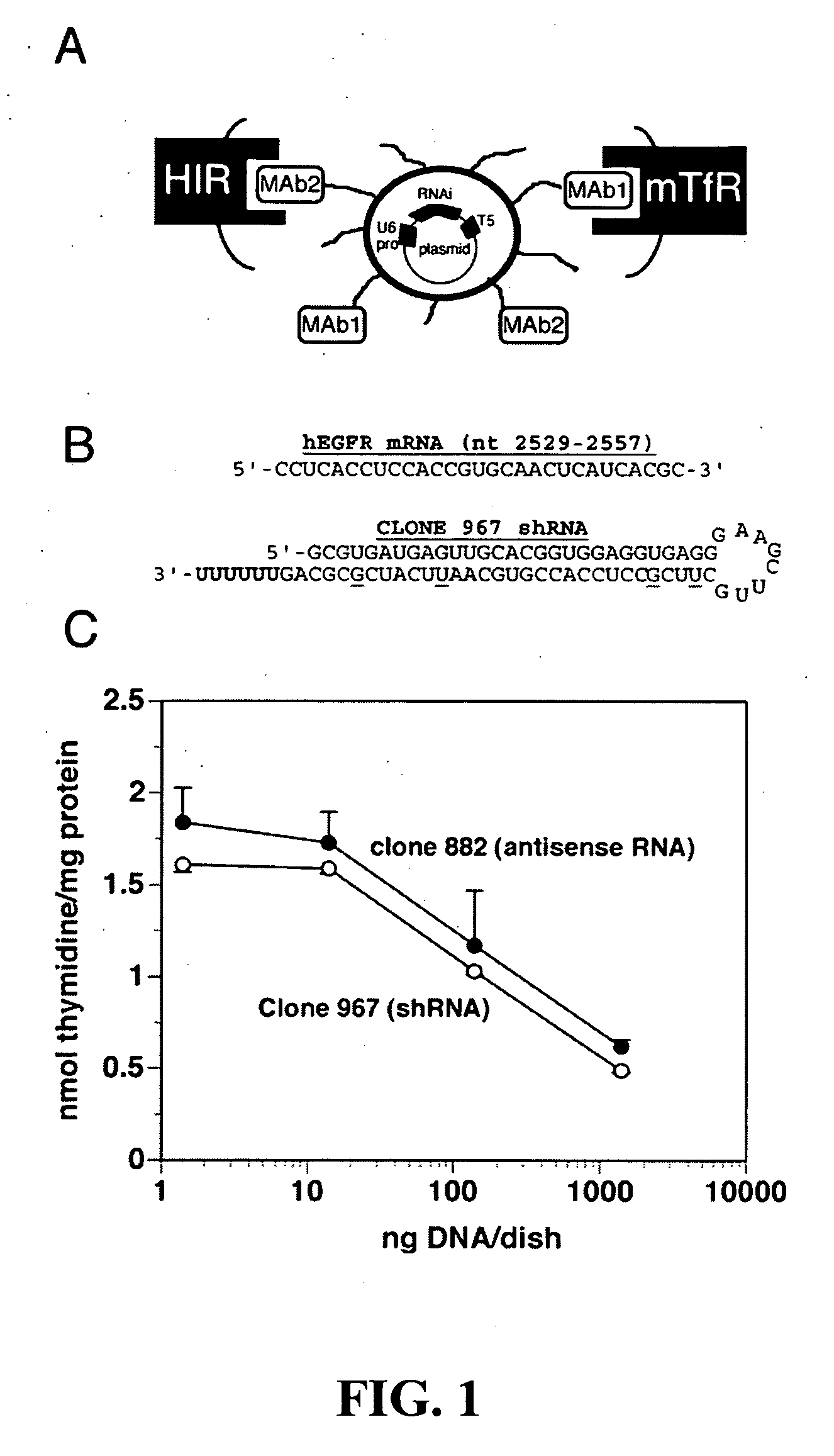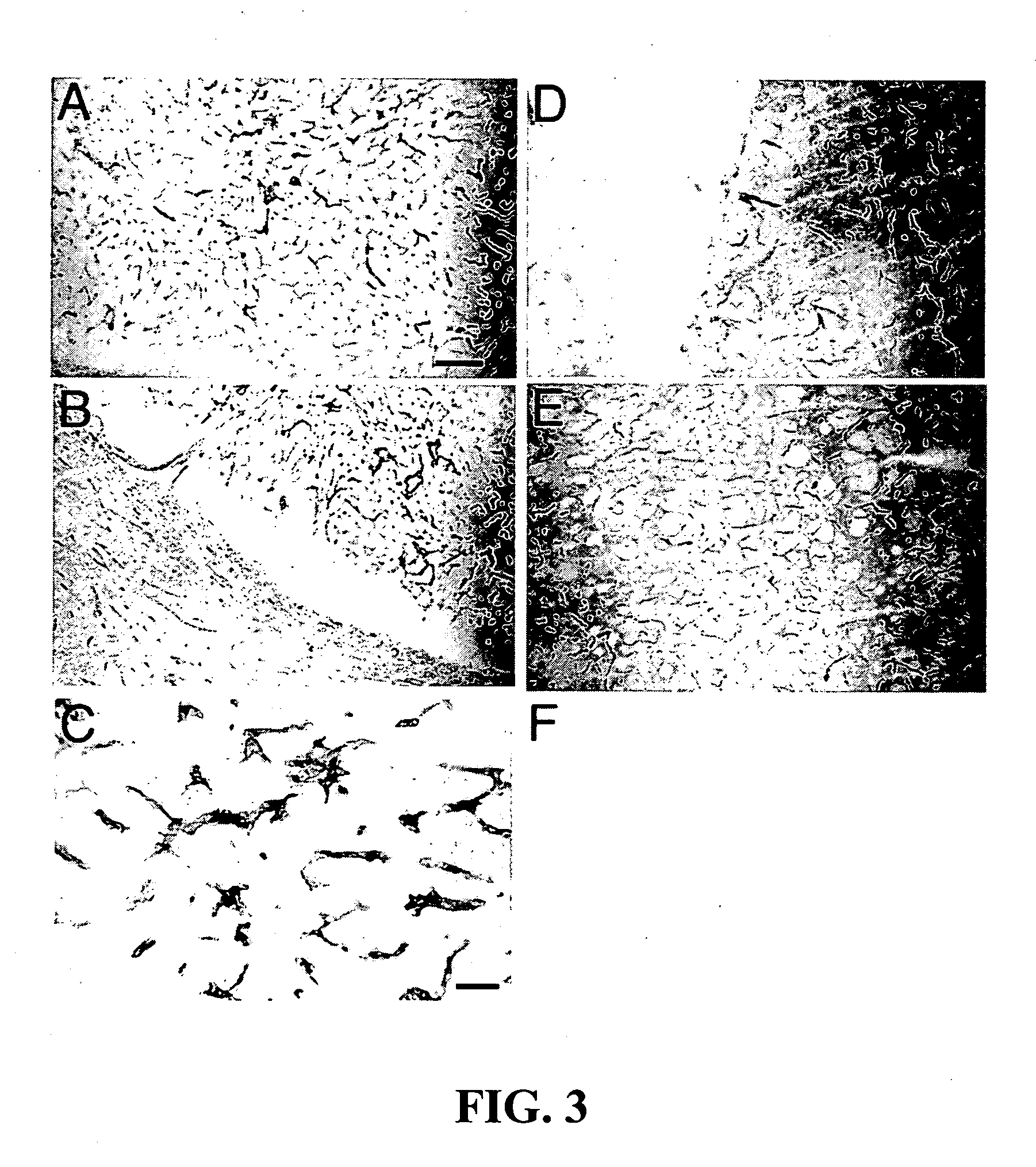Delivery of genes encoding short hairpin RNA using receptor-specific nanocontainers
- Summary
- Abstract
- Description
- Claims
- Application Information
AI Technical Summary
Benefits of technology
Problems solved by technology
Method used
Image
Examples
example 1
[0043] Design of shRNA encoding plasmid and demonstration of biological activity in cell culture. Oligodeoxynucleotide (ODN) duplexes corresponding to the various EGFR shRNAs were designed as described in the literature (28), and shown in Table 1.
TABLE 1Design of shRNA to target EGFR mRNA.List of ODNs used for the construction of expression plasmids.PlasmidEGFRNumbermRNA (nt)ODN sequence962187-219Forward:GCTGCCCCGGCCGTCCCGGAGGGTCGCATGAAGCTTGATGCGACTCTTCGGGACGGTCGGGGTAGCGCTTTTTT(SEQ. ID. NO. 3)Reverse:AATTAAAAAAGCGCTACCCCGACCGTCCCGAAGAGTCGCATCAAGCTTCATGCGACCCTCCGGGACGGCCGGGGCAGCGGCC(SEQ. ID. NO. 4)9632087-2119Forward:GATCTTAGGCCCATTCGTTGGACAGCCTTGAAGCTTGAGGGTTGTCCGACGAATGGGCCTAAGATTCCTTTTTT(SEQ. ID. NO. 5)Reverse:AATTAAAAAAGGAATCTTAGGCCCATTCGTCGGACAACCCTCAAGCTTCAAGGCTGTCCAACGAATGGGCCTAAGATCGGCC(SEQ. ID. NO. 6)9643683-3715Forward:GTCCTGCTGGTAGTCAGGGTTGTCCAGGCGAAGCTTGGTCTGGATAATCCTGACTATCAGCAGGACTTTTTTTT(SEQ. ID. NO. 7)Reverse:AATTAAAAAAAAGTCCTGCTGATAGTCAGGATTATCCAGACCAAGCTTCGCCTGGAC...
example 2
[0048] Western blotting. To confirm the inhibition of functional EGFR expression by RNAi in cell culture, we measured immunoreactive EGFR by Western blotting (FIG. 5) in cultured U87 cells following 48 hours exposure to clone 967 plasmid DNA. For controls, we measured the level of immunoreactive EGFR following exposure to clone 882 (conventional antisense gene therapy with EBNA-1), clone 962 (an ineffective anti-EGFR RNAi clone (Table 2), and clone 952 [an anti-luciferase gene RNAi clone, which should have no effect on the EGFR (ref. 19)]. Quantitation of the Western blot results show that clones 967 and 882 knocked down the EGFR 68% and 88%, respectively (FIG. 5).
[0049] Details of the Western blot are as follows:
[0050] Human U87 glioma cells were cultured on 35 mm dishes to 80% confluency. The individual plasmid DNA (clones 967, 882, 952, and 962) were applied in Lipofectamine at a dose of 1.5 mg DNA / dish for a 4 hour period. The medium was then removed and replaced with fresh me...
example 3
[0051] Demonstration of equivalency between Clones 882 (conventional antisense therapy with EBNA-1) and Clone 967 (DNA-based RNAi gene therapy without EBNA-1). U87 human glioma cells were grown in 6-well cluster dishes with MEM medium containing 10% fetal bovine serum (FBS). After the cells reached 50-60% confluence, the growth medium was replaced with 1.5 ml of serum-free MEM containing 1 μg of each plasmid DNA (clone 959, 962-964, 966-968, or 882) and 10 μl (20 μg) of Lipofectamine, and incubated for 4 hours at 37° C. The medium was replaced with MEM medium with 10% FBS and incubated for 24 hours. A final concentration of 2 μCi / ml of [3H]-thymidine and 10 μM of unlabeled thymidine were added to each dish, and dishes were incubated at 37° C. for 48 hours. The cells were harvested for measurement of [3H]-thymidine incorporation as described previously (14). The transfection of the U87 cells with Lipofectamine demonstrated that clone 967 was the most potent clone causing RNA interfer...
PUM
| Property | Measurement | Unit |
|---|---|---|
| Mass | aaaaa | aaaaa |
| Mass | aaaaa | aaaaa |
| Diameter | aaaaa | aaaaa |
Abstract
Description
Claims
Application Information
 Login to View More
Login to View More - R&D
- Intellectual Property
- Life Sciences
- Materials
- Tech Scout
- Unparalleled Data Quality
- Higher Quality Content
- 60% Fewer Hallucinations
Browse by: Latest US Patents, China's latest patents, Technical Efficacy Thesaurus, Application Domain, Technology Topic, Popular Technical Reports.
© 2025 PatSnap. All rights reserved.Legal|Privacy policy|Modern Slavery Act Transparency Statement|Sitemap|About US| Contact US: help@patsnap.com



